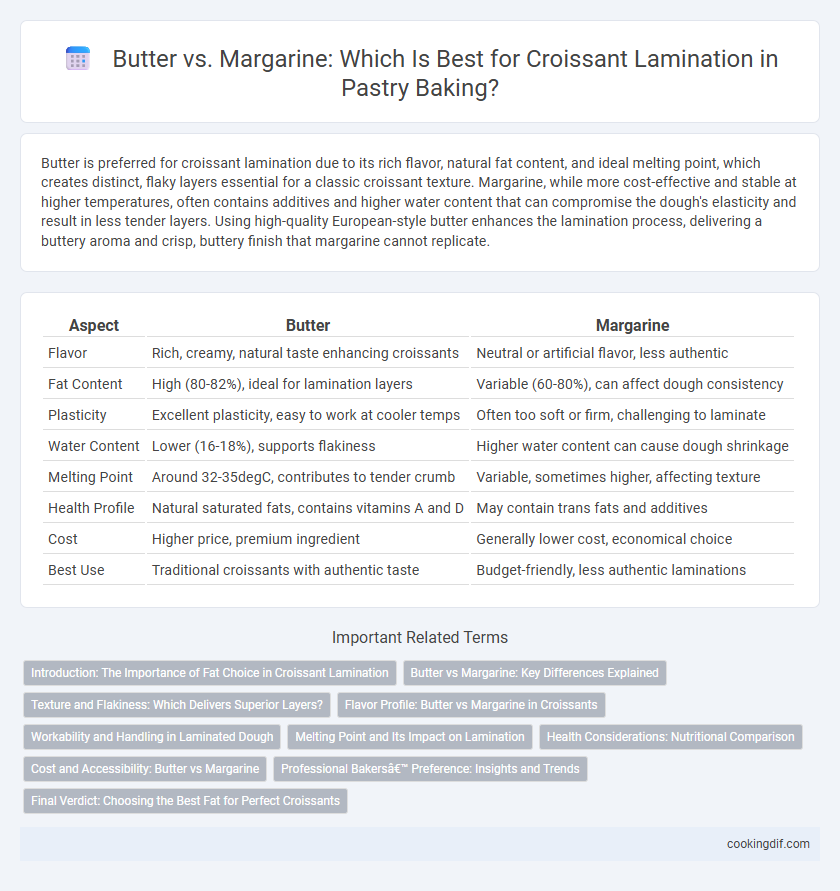Butter is preferred for croissant lamination due to its rich flavor, natural fat content, and ideal melting point, which creates distinct, flaky layers essential for a classic croissant texture. Margarine, while more cost-effective and stable at higher temperatures, often contains additives and higher water content that can compromise the dough's elasticity and result in less tender layers. Using high-quality European-style butter enhances the lamination process, delivering a buttery aroma and crisp, buttery finish that margarine cannot replicate.
Table of Comparison
| Aspect | Butter | Margarine |
|---|---|---|
| Flavor | Rich, creamy, natural taste enhancing croissants | Neutral or artificial flavor, less authentic |
| Fat Content | High (80-82%), ideal for lamination layers | Variable (60-80%), can affect dough consistency |
| Plasticity | Excellent plasticity, easy to work at cooler temps | Often too soft or firm, challenging to laminate |
| Water Content | Lower (16-18%), supports flakiness | Higher water content can cause dough shrinkage |
| Melting Point | Around 32-35degC, contributes to tender crumb | Variable, sometimes higher, affecting texture |
| Health Profile | Natural saturated fats, contains vitamins A and D | May contain trans fats and additives |
| Cost | Higher price, premium ingredient | Generally lower cost, economical choice |
| Best Use | Traditional croissants with authentic taste | Budget-friendly, less authentic laminations |
Introduction: The Importance of Fat Choice in Croissant Lamination
Butter provides a rich flavor and superior plasticity essential for creating the flaky, tender layers in croissant lamination. Margarine offers a more consistent fat content and melting point, which can enhance lamination precision but may compromise traditional buttery taste. The choice between butter and margarine directly impacts the croissant's texture, aroma, and overall quality.
Butter vs Margarine: Key Differences Explained
Butter and margarine differ significantly in composition, with butter made from cream and margarine from vegetable oils, impacting flavor and texture in croissant lamination. Butter's higher fat content and natural water phase create superior flakiness and taste, while margarine offers more plasticity and lower cost but can compromise the croissant's delicate layers. The choice between butter and margarine influences the lamination process, dough handling, and final pastry quality, making butter the preferred option for authentic French croissants.
Texture and Flakiness: Which Delivers Superior Layers?
Butter offers superior texture and flakiness for croissant lamination due to its natural fat content and water composition, which creates distinct, flaky layers during baking. Margarine often contains hydrogenated oils and additives that can result in less-defined layering and a denser crumb. Bakers seeking optimal croissant lamination performance typically prefer butter for its ability to deliver crisp, tender, and airy layers.
Flavor Profile: Butter vs Margarine in Croissants
Butter provides a rich, creamy flavor with natural sweetness and aromatic notes essential for authentic croissant lamination, enhancing the pastry's overall taste and mouthfeel. Margarine often contains additives and oils that can introduce a slightly processed or neutral flavor, which may not complement the delicate layers as effectively as butter. The choice between butter and margarine significantly influences the croissant's flavor complexity and traditional buttery aroma.
Workability and Handling in Laminated Dough
Butter offers superior workability and handling in croissant lamination due to its natural fat crystals, which create distinct, flaky layers and a tender crumb. Margarine, often formulated with higher melting points and added emulsifiers, provides more consistent dough plasticity but can result in less pronounced flakiness and potential greasiness. The choice impacts dough elasticity, folding ease, and final texture, with butter favored by traditional pastry chefs for optimal lamination outcomes.
Melting Point and Its Impact on Lamination
Butter with a melting point around 32-35degC creates distinct, flaky layers in croissant lamination due to its optimal plasticity, allowing even spreading without tearing the dough. Margarine, often having a higher melting point between 38-45degC, can result in less tender layers and may cause dough shrinkage or uneven lamination under heat. The precise melting point significantly influences dough flexibility and steam generation, essential factors for achieving the classic croissant rise and texture.
Health Considerations: Nutritional Comparison
Butter contains natural fats and essential nutrients like vitamins A and D, making it a traditional choice for croissant lamination that supports a richer flavor and texture. Margarine, often made from vegetable oils, may contain trans fats and additives, which can negatively impact heart health when consumed in excess. Choosing butter over margarine can provide better nutritional benefits, particularly for those prioritizing natural ingredients and avoiding artificial compounds.
Cost and Accessibility: Butter vs Margarine
Butter's higher cost and limited shelf life present challenges for large-scale croissant lamination, whereas margarine offers a more affordable and readily available alternative. Margarine's longer shelf stability and lower price point make it attractive for commercial bakeries aiming to reduce expenses without compromising workflow. However, the flavor profile and texture differences must be balanced against cost-efficiency when choosing between butter and margarine.
Professional Bakers’ Preference: Insights and Trends
Professional bakers overwhelmingly prefer butter for croissant lamination due to its superior flavor, natural fat composition, and optimal melting properties that create distinct, flaky layers. Margarine, while more cost-effective and longer-lasting, often lacks the rich aroma and elastic texture critical for achieving authentic, high-quality croissants. Current industry trends highlight a growing emphasis on premium ingredients, with artisan bakeries prioritizing European cultured butter to enhance lamination performance and final product taste.
Final Verdict: Choosing the Best Fat for Perfect Croissants
Butter remains the superior fat for croissant lamination, offering unparalleled flavor, aroma, and a tender crumb due to its natural milk solids and water content. Margarine provides a more stable fat structure, enhancing dough elasticity and easing lamination, but often lacks the rich taste and flaky texture associated with traditional croissants. For bakery professionals aiming for authentic, flaky, and flavorful croissants, high-quality European-style butter is the preferred choice despite the slightly higher cost and handling challenges.
Butter vs margarine for croissant lamination Infographic

 cookingdif.com
cookingdif.com